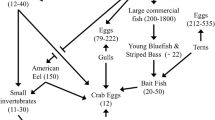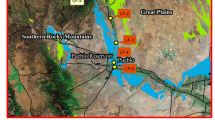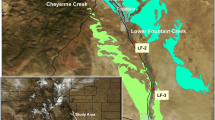Abstract
The Solomon River Basin is located in north-central Kansas in an area underlain by marine geologic shales. Selenium is an indigenous constituent of these shales and is readily leached into the surrounding groundwater. Portions of the Basin are irrigated primarily through the pumping of selenium-contaminated groundwater from wells onto fields in agricultural production. Water, sediment, macroinvertebrates, and fish were collected from various sites in the Basin in 1998 and analyzed for selenium. Selenium concentrations were analyzed spatially and temporally and compared to reported selenium toxic effect thresholds for specific ecosystem components: water, sediments, food-chain organisms, and wholebody fish. A selenium aquatic hazard assessment for the Basin was determined based on protocol established by Lemly. Throughout the Basin, water, macroinvertebrate, and whole fish samples exceeded levels suspected of causing reproductive impairment in fish. Population structures of several fish species implied that successful reproduction was occurring; however, the influence of immigration of fish from low-selenium habitats could not be discounted. Site-specific fish reproduction studies are needed to determine the true impact of selenium on fishery resources in the Basin.
Similar content being viewed by others
References
American Public Health Association (1995). In A. D. Eaton, L. S. Clesceri, A. E. Greenberg, & M. H. Franson (Eds.), Standard methods for the examination of water and wastewater (19th ed.). Washington, D.C.: American Public Health Association.
Bailey, R. M., & Harrison, H. M. (1948). Food habits of the southern channel catfish (Ictalurus lacustrus punctatus) in the Des Moines River, Iowa. Transactions of the American Fisheries Society, 75, 110–138.
Baumann, P. C., & Gillespie, R. B. (1986). Selenium bioaccumulation in gonads of largemouth bass and bluegill from three power plant cooling reservoirs. Environmental Toxicology and Chemistry, 5, 695–701.
Bennett, W. N., Brooks, A. S., & Boraas, M. E. (1986). Selenium uptake and transfer in an aquatic food chain and its effects on fathead minnow larvae. Archives of Environmental Contamination and Toxicology, 15, 513–517.
Berryman, A. A. (1981). Population systems, pp 222. New York, NY: Plenum.
Besser, J. M., Canfield, T. J., & La Point, T. W. (1993). Bioaccumulation of organic and inorganic selenium in a laboratory food chain. Environmental Toxicology and Chemistry, 12, 57–72.
Brumbaugh, W. G., & Walther, M. J. (1989). Determination of arsenic and selenium in whole fish by continuous-flow hydride generation atomic absorption spectrophotometry. Journal — Association of Official Analytical Chemists, 72, 484–486.
Canton, S. P., & Van Derveer, W. D. (1997). Selenium toxicity to aquatic life: An argument for sediment-based water quality criteria. Environmental Toxicology and Chemistry, 16, 1255–1259.
Christensen, V. G. (1999). Deposition of selenium and other constituents in reservoir bottom sediment of the Solomon River Basin, North-Central Kansas. Water Resources Investigations Report 99-4230. Lawrence, KS: U.S. Geological Survey.
Coughlan, D. J., & Velte, J. S. (1989). Dietary toxicity of selenium-contaminated red shiners to striped bass. Transactions of the American Fisheries Society, 118, 400–408.
Coyle, J. J., Bucker, D. R., & Ingersoll, C. G. (1993). Effect of dietary selenium on the reproductive success of bluegills (Lepomis macrochirus). Environmental Contamination and Toxicology, 12, 551–565.
DeForest, D. K., Brix, K. V., & Adams, W. J. (1999). Critical review of proposed residue-based selenium toxicity thresholds for freshwater fish. Human and Ecological Risk Assessment, 5, 1187–1228.
Gillespie, R. B., & Baumann, P. C. (1986). Effects of high tissue concentrations of selenium on reproduction by bluegills. Transactions of the American Fisheries Society, 115, 208–213.
Hamilton, S. J., Buhl, K. J., Faerber, N. L., Wiedmeyer, R. H., & Bullard, F. A. (1990). Toxicity of organic selenium in the diet of chinook salmon. Environmental Toxicology and Chemistry, 9, 347–358.
Hamilton, S. J., & Lemly, A. D. (1999). Water-sediment controversy in setting environmental standards for selenium. Ecotoxicology and Environmental Safety, 44, 227–235.
Hamilton, S. J., Palmisano, A. N., Wedemeyer, G. W., & Yasutake, W. T. (1986). Impacts of selenium on early life stages and smoltification of fall chinook salmon. Transactions of the North American Wildlife and Natural Resources Conference, 51, 343–356.
Hoffman, R. J., Hallock, R. J., Row, T. G., Lico, M. S., Burge, H. L., & Thompson, S. P. (1990). Reconnaisance investigation of water quality, bottom sediment, and biota associated with irrigation drainage in and near Stillwater Wildlife Management Area, Churchill County, Nevada, 1986–1987. USGS Water-Resources Investigations Report 89-4105.
Juracek, K. E., & Ziegler, A. C. (1998). Selenium in reservoir sediment from the Republican River Basin. U.S. Geological Survey Fact Sheet FS-080-98. U.S. Geological Survey and U.S. Bureau of Reclamation.
Lemly, A. D. (1982). Response of juvenile centrarchids to sublethal concentrations of waterborne selenium. I. Uptake, tissue distribution, and retention. Aquatic Toxicology, 2, 235–252.
Lemly, A. D. (1985a). Ecological basis for regulating aquatic emissions from the power industry: The case with selenium. Ecotoxicology and Environmental Safety, 5, 465–486.
Lemly, A. D. (1985b). Toxicology of selenium in a freshwater reservoir: Implications for environmental hazard evaluation and safety. Ecotoxicology and Environmental Safety, 10, 314–338.
Lemly, A. D. (1993a). Guidelines for evaluating selenium data from aquatic monitoring and assessment studies. Environmental Monitoring and Assessment, 28, 83–100.
Lemly, A. D. (1993b). Metabolic stress during winter increases the toxicity of selenium to fish. Aquatic Toxicology, 27, 133–158.
Lemly, A. D. (1995). A protocol for aquatic hazard assessment of selenium. Ecotoxicology and Environmental Safety, 32, 280–288.
Lemly, A. D. (1999). Selenium impacts on fish: An insidious time bomb. Human and Ecological Risk Assessment, 5, 1139–1151.
Lemly, A. D. (2002). Interpreting selenium concentrations. In D. E. Alexander (Ed.), Selenium assessment in aquatic ecosystems: A guide for hazard evaluation and water quality criteria (pp. 18–38). New York: Springer.
Lemly, A. D., & Smith, G. J. (1987). Aquatic cycling of selenium — Implications for fish and wildlife. U.S. Fish and Wildlife Service leaflet 12, 10p.
Masscheleyn, P. H., Delaune, R. D., & Patrick, W. H. (1991). Arsenic and selenium chemistry as affected by sediment redox potential and pH. Journal of Environmental Quality, 20, 522–527.
May, T. W., Walther, M. J., Petty, J. D., Fairchild, J. F., Lucero, J., Devaux, M., et al. (2001). An evaluation of selenium concentrations in water, sediment, invertebrates, and fish from the Republican River Basin: 1997–1999. Environmental Monitoring and Assessment, 72, 179–206.
Ogle, R. S., & Knight, A. W. (1989). Effects of elevated foodborne selenium on growth and reproduction of the fathead minnow (Pimephales promelas). Archives of Environmental Contamination and Toxicology, 18, 795–803.
Peterson, J. A., & Nebeker, A. V. (1992). Estimation of waterborne selenium concentrations that are toxicity thresholds for wildlife. Archives of Environmental Contamination and Toxicology, 23, 154–162.
Saiki, M. K. (1986a). Concentrations of selenium in aquatic food-chain organisms and fish exposed to agricultural tile drainage water. In Selenium and agricultural drainage: Implications for San Francisco Bay and the California environment. Proceedings of the Second Selenium Symposium (pp. 25–53). Tiburon, CA: The Bay Institute of California.
Saiki, M. K. (1986b). A field example of selenium contamination in an aquatic food chain. In Proceedings of First Annual Environmental Symposium: Selenium in the Environment. California Agricultural Technology Institute Publication No. CAT/860201. Fresno, CA. California State University, pp. 67–76.
Saiki, M. K., & Lowe, T. P. (1987). Selenium in aquatic organisms from subsurface agricultural drainage water, San Joaquin Valley, California. Archives of Environmental Contamination and Toxicology, 16, 657–670.
Schuler, C. A. (1989). Selenium and boron accumulation in wetlands and waterfowl food at Kesterson reservoir. In A. Q. Howard (Ed.), Selenium and agricultural drainage: Implications for San Francisco Bay and the California environment. Proceedings of the Fourth Selenium Symposium (pp. 91–101). Tiburon, CA: The Bay Institute of San Francisco.
Schuler, C. A., Anthony, R. G., & Ohlendorf, H. M. (1990). Selenium in wetlands and waterfowl foods at Kesterson reservoir, California, 1984. Archives of Environmental Contamination and Toxicology, 45, 568–853.
Schultz, R., & Hermanutz, R. (1990). Transfer of toxic concentrations of selenium from parent to progeny in the fathead minnow (Pimephales promelas). Bulletin of Environmental Contamination and Toxicology, 45, 568–573.
Skorupa, J. P. (1998). Selenium poisoning of fish and wildlife in nature: Lessons from twelve real-world examples. In W. T. Frankenberger & R. A. Engberg (Eds.), Environmental chemistry of selenium (pp. 315–354). NY: Marcel Dekker.
Skorupa, J. P., Morman, S. P., & Sefchick-Edwards, J. S. (1996). Guidelines for interpreting selenium exposures of biota associated with nonmarine aquatic habitats. Sacramento, CA. U.S. Fish and Wildlife Service, Sacramento Field Office, Technical Report.
U.S. Bureau of Reclamation (2001). Chapter III., Affected environment and environmental consequences. In Solomon River Basin Draft Environmental Assessment: Conversion of long-term water service contracts to repayment contracts (pp. 1–82). Grand Island, NE: Great Plains Region, Billings MO and Nebraska-Kansas Area Office.
U.S. Environmental Protection Agency (1996). EPA SW-846 test methods for evaluating solid waste, revision 2. Washington, D.C.: Office of Solid Waste and Emergency Response.
U.S. Environmental Protection Agency (1998). Methods for chemical analysis of water and wastes. EPA-600/4-79-020. Cincinnati, OH: Environmental Monitoring and Support Laboratory, Office of Research and Development.
U.S. Environmental Protection Agency (2004). Draft selenium aquatic life criterion: Fact sheet (December 2004), at web address http://www.epa.gov/seleniumcriteria/fs.htm.
U.S. Environmental Protection Agency (2005). Current national recommended water quality criteria, at web address http://epa.gov/waterscience/criteria/wqcriteria.html.
Van Derveer, W. D., & Canton, S. P. (1997). Selenium sediment toxicity thresholds and derivation of water quality criteria for freshwater biota of western streams. Environmental Toxicology and Chemistry, 16, 1260–1268.
Author information
Authors and Affiliations
Corresponding author
Additional information
The U.S. Government’s right to retain a non-exclusive, royalty free license in and to any copyright is acknowledged.
Rights and permissions
About this article
Cite this article
May, T.W., Fairchild, J.F., Petty, J.D. et al. An evaluation of selenium concentrations in water, sediment, invertebrates, and fish from the Solomon River Basin. Environ Monit Assess 137, 213–232 (2008). https://doi.org/10.1007/s10661-007-9742-y
Received:
Accepted:
Published:
Issue Date:
DOI: https://doi.org/10.1007/s10661-007-9742-y




